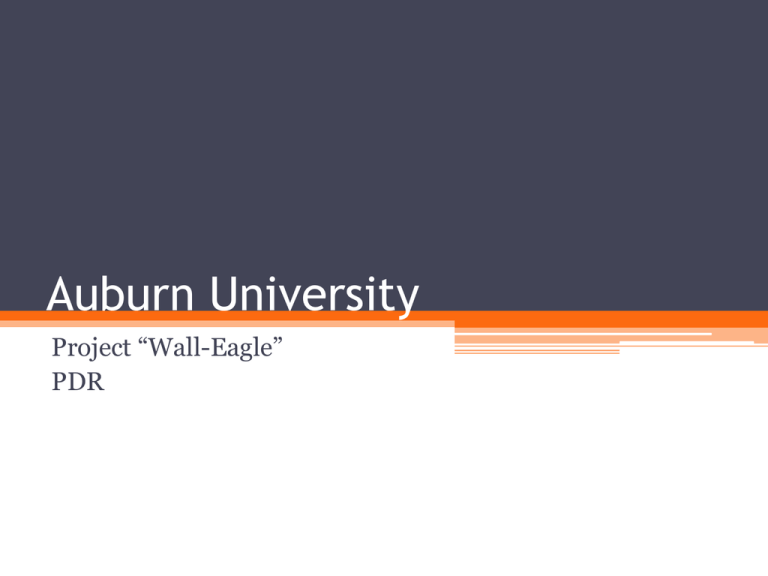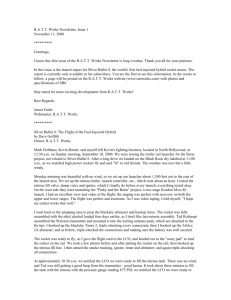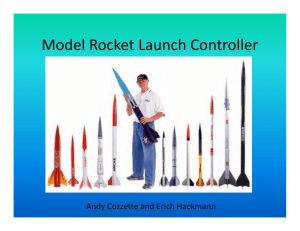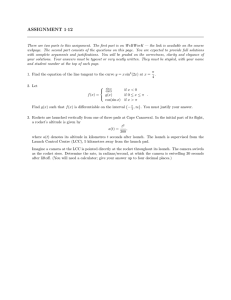Auburn University Project “Wall-Eagle” PDR
advertisement

Auburn University Project “Wall-Eagle” PDR Rocket Design Rocket Model Detailed Sections Mass Estimates Section Structure Supporting Equipment Electronics Recovery Motor Total Mass Growth Mass Allowance Mass (lb.) 8.577 9.444 1.5 2.516 6.47 28.5 3.7 32.2 Percentage of Total Weight 33.58% 31.47% 5.00% 8.39% 21.56% N/A 12.98% 113% Ogive Nose Cone • • • • Low Coefficient of Drag Easy to manufacture Rated highest by team trade study Commonly used in professional and hobby rocketry Nose Cones Type of Cone Coefficient Of Mass Drag Ease of Manufacturing Total Ogive 3 2 2 7 Haack 3 2 1 6 Ellipsoid 1 1 2 4 Conical 1 3 3 7 Trapezoidal Fin • Very easy to manufacture • Less drag than clipped delta fins, more than elliptical fins • Quicker stabilization than elliptical fins and clipped delta fins. Fins Type of Fin Stability Ease of Drag manufacturing Total Trapezoidal 10 10 8 28 Clipped Delta 8 10 7 25 Elliptical 7 7 10 24 Motor Selection Motor Selection / Altitude Prediction • Initial Motor selection is the Aero K780R-P ▫ R-P: Redline, Plugged • Initial thrust-to-weight ratio above required 5:1 • Achieves above average thrust within ¼ second • High initial thrust provides high stability off the rail K780R-P Thrust curve Motor Selection/Altitude Prediction • Maximum altitude achieved 3395 feet • Mass increase of 12.97% altitude gives a projected 3045 feet • Assumptions include smooth construction and 5 mph winds • Mass increase of 25% would not allow rocket to reach desired altitude K780R-P Altitude vs. Time Figure 1.3: Altitude vs. Time K780R-P 3500 3000 Altitude (feet) 2500 2000 1500 1000 500 0 0 -500 10 20 30 40 50 Time (seconds) 60 70 80 90 100 K780R-P Motor Specifications Manufacturer AeroTech Motor Designation K780R-P Diameter 75 mm Length 15.5 inches Impulse 2371 N-sec Total Motor Weight 5.95 lbm Propellant Weight 2.8 lbm Propellant Type Redline Average Thrust 175 Pounds Maximum Thrust 216 Pounds Burn Time 3.0 sec Secondary Motor • Secondary motor is the CTI L-610 • Mass increase of 25% altitude simulated 3245 feet • Increased mass would utilize ballast tank • Would require an increased fin size for maintaining stability Cesaroni L-610 Motor Specifications Manufacturer Cesaroni Technologies Incorporated Motor Designation L-610 Diameter 75 mm Length 15.5 inches Impulse 3130.9 N-sec Total Motor Weight 8.71 lbm Propellant Weight 3.5 lbm Propellant Type Redline Average Thrust 137 Pounds Maximum Thrust 197 Pounds Burn Time 5.1 Seconds Recovery Overview Parachutes • Three parachutes required ▫ Drogue – 20 inches* ▫ Main – 140 inches* ▫ Payload – 36 inches* * Estimates using standard round parachute without spillholes. Parachutes • Construction ▫ Shape Semi-ellipsoidal No spill hole Electronics • Avionics bay ▫ Two altimeters Altus Metrum Telemetrum PerfectFlite StratoLogger Attachments • Fasteners ▫ Nylon Slotted Pan Head Machine Screws ▫ Steel U-Bolts ▫ Quick Links Parachute Materials • The parachute will be made of Ripstop nylon • Ripstop’s tear resistant weaving is ideal for parachute making Shock Cord Material • The shock cord will be made of 1” tubular nylon • 1” tubular nylon has excellent tensile properties • A vendor has already been secured • The Auburn team has worked with this material before CO2 Ejection System • Increased safety • More reliable at high altitudes • Reduced risk of equipment damage Commercial Systems • Available from Rouse Tech and Tinder rocketry • Viability of CO2 systems repeatedly demonstrated in the field • A single 12g cartridge is recommended for a 5” diameter rocket with sections up to 22” long. Custom Designed System • E-match ignites small Pyrodex charge • Charge pushes cartridge against spring into an opening pin • Cartridge is punctured and quickly releases CO2 • Section is pressurized with enough force to separate rocket and deploy parachutes Custom Designed System • Each system contains three CO2 cartridges • Each cartridge is separately controlled • Dual fault tolerance Ejection System Implementation • • • • Two ejection systems total mounted outside the avionics bay One system deploys drogue parachute and ejects payload bay Second system deploys main parachute Two altimeters, each controls two CO2 cartridges on each system Autonomous Ground Support Equipment – Project WALL-Eagle Overall AGSE Concept Overall AGSE Concept AGSE Payload Hatch Payload Hatch Function • Seals payload bay during flight • Hatch opens and closes autonomously with a microservo • Guides robotic arm into payload bay Payload Access Plate and Positioning • Single access plate revolves on hinge • Hinge operates with microservo • Will allow remote opening and closing • Optical markers to guide robotic arm Payload Access Plate and Positioning • Single access plate revolves on hinge • Hinge operates with microservo • Will allow remote opening and closing • Optical markers to guide robotic arm Payload Hatch Animation AGSE Payload Capture & Transport Robot Arm Capabilities • Needs at least 4 degrees of freedom • Controlled by central master-controller • Detect Payload via IR sensors ▫ Backup: Navigate to predetermined location • Be able to lift 4 oz. payload • Navigate over payload and rocket hatch Fabricated vs. Purchased Fabrication Advantages: ▫ Customizable for any purpose ▫ Cost-effective ▫ Deep subsystem educational merit ▫ Unique and original ▫ High scientific merit Purchase Advantages ▫ Commit team-member time elsewhere ▫ High-performance ▫ Reduce risk of subsystem failure ▫ Compensate for lack of teammember experience ▫ Customizable parts ▫ High scientific merit Decision: Purchase Robot Arm • Chose to purchase commercially available arm. • High performance, legacy, and affordability warrant purchase of arm. • Arm like Lynxmotion AL5B or AL5D possible choices. CrustCrawler AX-12A Smart Robotic Arm • ~22” maximum reach • 5-6 degrees of freedom • Most value and capabilities for the price • Completely customizable • Price - $830 CrustCrawler AX-12A Key Features • 1mbs serial communication protocol Dual actuator design in the shoulder and wrist axis for maximum lifting capability (2 to 3 pound (.907kg to 1.36kg) Fully ROS,MATLAB,LABVIEW Compatible! • • Rugged, all aluminum construction for maximum kinematic accuracy (1mm - 3mm) Hard Anodized finish for maximum scratch and corrosion resistance Compatible with ANY micro-controller/computer control system / programming Language (Open Source!) The only robotic arms that feature feedback for position, voltage, current and temperature • Smooth, sealed, self lubricating ball bearing turntable • • (3) integrated mounting tabs for easy mounting to a fixed or mobile base (5) Gripper options to choose from Fully adjustable initial base angle Full control over position (300 degrees), speed, and torque in 1024 increments • Automatic shutdown based on voltage or temperature with status indicator LED Sensor engineered gripper design accepts, pressure sensors, IR detectors, CCD cameras and more! Robot Arm Gripper Requirements • • • • • • Able to hold cylindrical payload Support 4 oz. weight Reach ground/reach payload bay Able to rotate at the wrist Able to sense that payload has been obtained The Big Grip Kit from the CrustCrawler AX-12A series robotic arms meet criteria plus more IR Sensors • Affixed to front of grabber, scans dark ground (grass/dirt) for light surface (payload). • Arm engages payload once detected. • If payload dropped, search and capture of the payload may be repeated until mission success Contingency: Preprogrammed Location • Use preprogrammed location of payload in case IR sensors plan doesn’t work out • Can choose location of payload, so static coordinates suffice • Easier, but will cause launch failure if payload dropped AGSE Launch Rail and Truss AGSE Truss • Constructed out of durable carbon fiber • Designed to support the full weight of the rocket • Connected to two electric gear motors • Rotates from horizontal to 85° • Returns to horizontal after rocket launch AGSE Truss • Bottom is counterweighted to ease lifting • Measurements ensure bottom does not contact the ground • Rocket attached to truss via slotted rails • Attachment rails double as launch rails ensuring launch stability • Truss will lock in vertical position once erect AGSE Truss • In launch position, blast shield protects sensitive components • Igniter insertion system extends into motor • Rocket is then ready for inspection • Once inspected, rocket is ready for launch AGSE Igniter Insertion System Igniter Insertion System • Toothed insertion system • DC electric motor drives the tooth extender into the mast • Initiated with a program that is linked to the AGSE controller Igniter Insertion System • Located 6-8 inches below the base of the rocket. • Main motor is protected by the blast plate • Rise through a whole in the blast plate to access the rocket Igniter Insertion System • Extension of 21 inches • Igniter pause at full extension • E-match attached to tip of the insertion system is in contact with motor • Inspection and arming of the rocket • Countdown ensues, followed by blast off Igniter Inserter System Master Microcontroller and Full System Operation Master Microcontroller • Single microcontroller drives all AGSE functions ▫ Simplifies design ▫ Minimizes risk ▫ Eliminates communication between multiple microcontrollers • Arduino mega or comparable device used Subsystem Connectivity • All autonomous systems connected through microcontroller ▫ Only launch controller handled independently • Single start, pause, and reset switches Nominal AGSE Process • Start command received • Robotic arms commanded to find payload • Arm deposits payload in rocket • Payload bay hatch closes • Launch rail raised • Igniter inserted • Sequence pauses • Launch button depressed • Rocket launches AGSE Flow Chart • System inspected prior to launch • In some cases it is possible to reset and re-run sequence in an error has occurred Risks • • • • Power Failure Programming Errors Equipment Assembly Errors Component Synchronization Failure • Sequence exceeds allotted time (10 minutes) • System unresponsive • Damage from environment (humidity, rain) Test Plans • Full system test (normal conditions) • Off-design rocket mass • Off-design payload configuration • Partially drained batteries • Power failure during AGSE sequence • Dropped payload Safety Section Construction Safety Techniques • All members sign a form for their understanding of lab safety practices • Proper personal protective equipment will be easily accessible and in good condition • Proper hazardous material disposal units will be easily accessible • Proper safety equipment is in place in all labs Testing Safety Techniques • Proper protective systems will be in use during testing practices • Safe testing guidelines will be posted in the testing facilities • Testing equipment will have sign-out sheets • Testing checklist will be proactively filled out Operations Safety Techniques • Safe range practices will be strictly enforced • Checklists for transport, assembly, and launch procedures will be completed • Locations for safe observation of Auburn launches will be marked off • Personnel will be properly trained for launch and recovery procedures Incident Safety • Standard operating guidelines are in place for different emergencies with easy access • Material Safety Data Sheets will be posted in all facilities • Proper precautions will be taken to ensure a safe working environment • Emergency incident operations will be required training for all organizational personnel Educational Outreach 7th Grade Rocket Week Students Learn About: • • • • Gravity and g-forces Newton’s Laws of Motion Elementary rocketry Science, technology, engineering, and mathematics • Teamwork and communication 7th Grade Rocket Week Students Work Hands-On: • Assembling an Alpha rocket in teams of 2-3 • Sanding, gluing, and painting rockets • Initiating and observing rocket launches Educational Outreach Programs • Auburn Junior High School/Auburn High School Rocket Team ▫ Mentor team to compete in Team America Rocketry Challenge ▫ Teach students design and technical writing methods ▫ Provide facilities and equipment for team use • Boy Scout Merit Badge University ▫ Teach troops about space exploration ▫ Supervise Alpha rocket assembly ▫ Award Space Exploration Merit Badge Educational Outreach Programs • Tuskegee Airmen National Historic Site Field Trip ▫ Guide Drake Middle School students on half-day field trip • Samuel Ginn College of Engineering E-Day ▫ Present AURA and Student Launch teams to prospective students • AURA Movie Night Event ▫ Show Apollo 13 at Tiger 13 Cinemas ▫ Provide Q&A with engineers and students Additional Information • Budget Summary • Timeline Summary Questions







